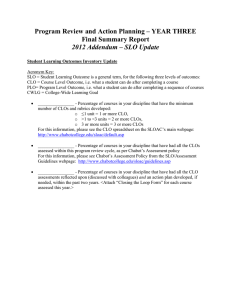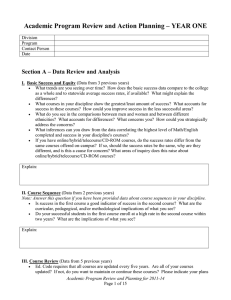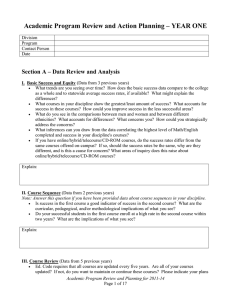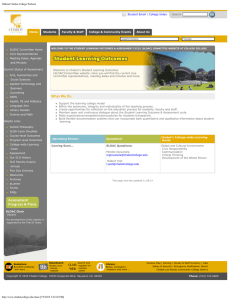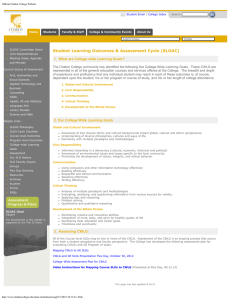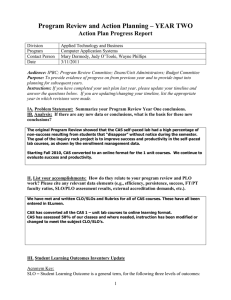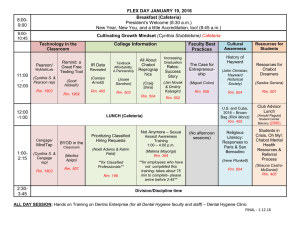Academic Program Review and Action Planning – YEAR ONE
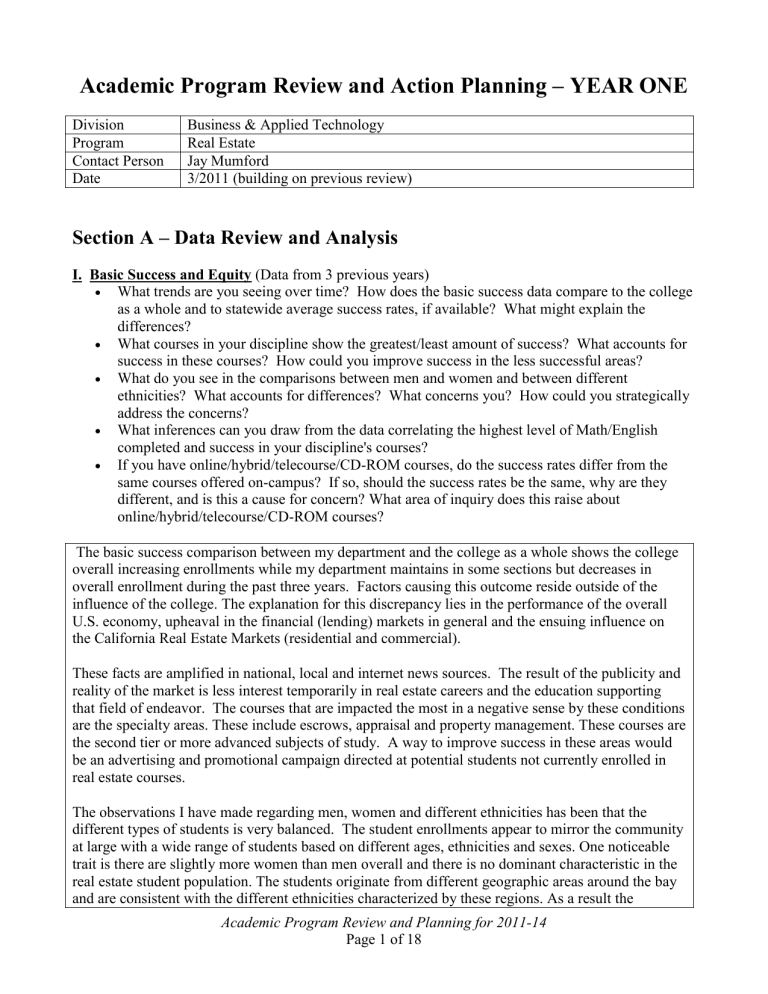
Academic Program Review and Action Planning – YEAR ONE
Division
Program
Business & Applied Technology
Real Estate
Contact Person Jay Mumford
Date 3/2011 (building on previous review)
Section A – Data Review and Analysis
I. Basic Success and Equity (Data from 3 previous years)
What trends are you seeing over time? How does the basic success data compare to the college as a whole and to statewide average success rates, if available? What might explain the differences?
What courses in your discipline show the greatest/least amount of success? What accounts for success in these courses? How could you improve success in the less successful areas?
What do you see in the comparisons between men and women and between different ethnicities? What accounts for differences? What concerns you? How could you strategically address the concerns?
What inferences can you draw from the data correlating the highest level of Math/English
completed and success in your discipline's courses?
If you have online/hybrid/telecourse/CD-ROM courses, do the success rates differ from the same courses offered on-campus? If so, should the success rates be the same, why are they different, and is this a cause for concern? What area of inquiry does this raise about online/hybrid/telecourse/CD-ROM courses?
The basic success comparison between my department and the college as a whole shows the college overall increasing enrollments while my department maintains in some sections but decreases in overall enrollment during the past three years. Factors causing this outcome reside outside of the influence of the college. The explanation for this discrepancy lies in the performance of the overall
U.S. economy, upheaval in the financial (lending) markets in general and the ensuing influence on the California Real Estate Markets (residential and commercial).
These facts are amplified in national, local and internet news sources. The result of the publicity and reality of the market is less interest temporarily in real estate careers and the education supporting that field of endeavor. The courses that are impacted the most in a negative sense by these conditions are the specialty areas. These include escrows, appraisal and property management. These courses are the second tier or more advanced subjects of study. A way to improve success in these areas would be an advertising and promotional campaign directed at potential students not currently enrolled in real estate courses.
The observations I have made regarding men, women and different ethnicities has been that the different types of students is very balanced. The student enrollments appear to mirror the community at large with a wide range of students based on different ages, ethnicities and sexes. One noticeable trait is there are slightly more women than men overall and there is no dominant characteristic in the real estate student population. The students originate from different geographic areas around the bay and are consistent with the different ethnicities characterized by these regions. As a result the
Academic Program Review and Planning for 2011-14
Page 1 of 18
program diversity is quite balanced and consistent with our overall student population. Recent
Perkins Funding core data studies have shown that the number of students from an economically disadvantaged background is greater for real estate related students than nearly every other CTE area of study. This indicates that Chabot’s real estate students benefit directly and in a tangible way as a result of completing real estate course work.
II. Course Sequence (Data from 2 previous years)
Note: Answer this question if you have been provided data about course sequences in your discipline.
Is success in the first course a good indicator of success in the second course? What are the
curricular, pedagogical, and/or methodological implications of what you see?
Do your successful students in the first course enroll at a high rate in the second course within two years? What are the implications of what you see?
It is true that the students who have a good learning experience due to their efforts and input along with a well run course by the instructor have a higher rate of enrollment in other courses within the program in sequence. I have noticed students will enroll in the following course in sequence even when a high grade was not achieved in the first course. This I surmise is a result of a good learning experience for the student and a possible esprit de corps or camaraderie having been established with other students within the program.
III. Course Review (Data from 5 previous years)
Ed. Code requires that all courses are updated every five years. Are all of your courses updated? If not, do you want to maintain or continue these courses? Please indicate your plans in terms of curriculum. Have all of your courses been offered recently? If not, why? Are students counting on courses to complete a program or major when these courses are not being offered?
Academic Program Review and Planning for 2011-14
Page 2 of 18
All of the courses have been updated within the past five years. There are no major changes planned in the curriculum. The curriculum will be subject to minor adjustments, but the overall program will continue with the current direction and focus. The changes that take place will be within current courses to adjust to any changes in DRE statutes as well as changes in market conditions.
All courses have been offered recently with the exception of “advanced” legal aspects and real estate taxation. These courses are highly specialized and with limited enrollments during the past three years the demand has not existed for these courses. The absence of these offerings does not prevent students from completing a program course or major due to the full offering of other courses and multiple sections. A number of offerings have been curtailed due to cuts by the division dean as a result of budgetary limitations. The plan is to keep the critical courses that lead to student objectives of pursuing real estate as a career in a rotation. The plan is to provide a selection of courses in rotation through alternate semesters.
IV. Budget Summary (Data from 3 previous years)
What budget trends do you see in your discipline? What are the implications of these trends?
Where is your budget adequate and where is it lacking? What are the consequences on your program, your students, and/or your instruction?
What projected long-term (5-10 years) budget needs do you see? You will detail your short-term needs in the action plan that follows. You do not need to cite them here.
Academic Program Review and Planning for 2011-14
Page 3 of 18
My program operates on a budget that for all practical purposes is consumed by the cost of faculty.
The primary increase in overhead and expenses have been due to negotiated faculty expenses.
The budget trends tend to be increasing with an emphasis on electronic, software tools, MLS training, audio video digital transmission of information. The direction of the field is toward technology assisted delivery of information, which is being addressed through online modalities. The budget has been inadequate in providing for faculty to teach courses outside of the program core offerings.
The consequence to my program are serious in that limiting the course offerings students will find those courses elsewhere and the program will suffer diminished enrollments over time. The quality of the education suffers as well when a variety of courses face to face as well as online are not offered.
I see a need to re-build the adjunct faculty over the next 5-10 years to satisfy the job market demand for individuals with real estate qualifications. The United States Department of Labor Bureau of
Labor Statistics Occupational Outlook Handbook projects strong demand for real estate agents and brokers through 2018. The Outlook Hand book states that “Employment of real estate brokers and agents is expected to grow faster than average”. “ Real estate brokers and sales agents are older, on average, than most other workers, and many are expected to leave the occupation over the next decade.”
Grow faster than average Increase 14 to 19 percent
The projected number of real estate brokers and sales agents is targeted for 16% growth through
2018. See http://www.bls.gov/oco/ocos120.htm#projections_data
In order to satisfy this need and prepare our students to meet the increased job demand there will be a budgetary need to staff up the department with qualified adjuncts to serve our students. This will require a gradual increase beginning in 2012 and escalating through 2015 and beyond.
The budget will also need to accommodate off campus (satellite) course offerings as well. This is due to the nature of the student taking one or two courses per semester in a location more convenient and accessible to meet their changing needs. This has been accomplished successfully in San Leandro and could be achieved in Dublin/Pleasanton as well.
V. Enrollment Data (Data from 2 previous years)
Please provide a brief description of: overall enrollment trends; enrollment trends by course; and enrollment trends by time of day and Saturday.
Describe what your discipline has done in terms of curriculum or scheduling in the last two years that has effected enrollments.
Describe plans or strategies that you have for the near future in terms of curriculum or scheduling that could impact your enrollments.
Lastly, look closely at whether the schedule you currently offer provides access to the broader community that your discipline serves at Chabot College—day time, night time, Saturday,
Academic Program Review and Planning for 2011-14
Page 4 of 18
distance education, special or targeted communities that would or do enroll in your courses.
The enrollment has been trending toward reduced enrollments over the past two years. This is consistent with the sharp downturn in the real estate market. This is to be expected as the real estate industry is cyclical. The trend has been downward in all courses and for the core program course stabilization seems evident at this time. These core courses are RE80 Principles, RE82a Appraisal,
RE81a Legal Aspects, RE83 Finance, and RE84 Practice. Other courses of a specialized nature office management, escrow, economics and property management are contracting due to the specialized and limited nature of the course focus.
The Monday/Wednesday am courses are experiencing favorable enrollments, while Friday am enrollments have been down as well as Tuesday/Thursday evenings. Saturday am enrollment has held well with one or two courses offered at this time.
The discipline has maintained consistent scheduling to assist student planning by providing a schedule that will be the same from semester to semester to aid in student planning. Also the department has maintained Saturday courses to accommodate students with personal schedules that do not allow for weekday attendance to class. The discipline is reaching out to students via the satellite campus at San Leandro with a core course offering for students in that geographic area.
The schedule has also expanded online course offerings with a positive acceptance from students as evidenced by strong enrollments in online sections. The future plan is for online offerings to eventually provide all of the courses online that are available in traditional format on campus. This could potentially have a significant positive impact on future enrollments.
The current schedule offers excellent access for students with a wide variety of locations as well as day and time availabilities. In addition the online course offerings expand student access even further through the distance education delivery format.
VI. Student Learning Outcomes Inventory
Acronym Key:
Academic Program Review and Planning for 2011-14
Page 5 of 18
SLO = Student Learning Outcome is a general term, for the following three levels of outcomes:
CLO = Course-level Outcome, i.e. what a student can do after completing a course
PLO= Program-level Outcome, i.e. what a student can do after completing a sequence of courses
CWLG = College-wide Learning Goal
Percentage of courses in your discipline that have CLOs and rubrics developed:
For this information, please see the list of which courses do and do not have CLOs on the
SLOAC’s main webpage: http://www.chabotcollege.edu/sloac/default.asp
Percentage of courses in your discipline that have the minimum number of CLOs developed:
(1 unit = 1 or more CLO, 2 units = 2 or more CLOs, 3 or more units = 3 or more CLOs)
For this information, please see the CLO spreadsheet on the SLOAC’s main webpage: http://www.chabotcollege.edu/sloac/default.asp
Date the CLO Assessment schedule was submitted:
For this information, please see the Course-level Outcomes assessment schedules list from the
Assessment Progress and Plans webpage: http://www.chabotcollege.edu/sloac/progress.asp
Percentage of courses in your discipline that have had all the CLOs assessed within the past three years, as per Chabot’s Assessment policy: _______
For this information, please see Chabot’s Assessment Policy from the SLO/Assessment
Guidelines webpage: http://www.chabotcollege.edu/sloac/guidelines.asp
Percentage of courses in your discipline that have had all the CLO assessments reflected upon, or discussed with colleagues, within the past three years_______
What questions or investigations arose as a result of these reflections or discussions?
Explain:
What actions has your discipline determined that might be taken as a result of these reflections, discussions, and insights?
Actions planned:
What course-level and programmatic strengths have the assessment reflections revealed?
Strengths revealed:
Percentage of programs within your discipline that have established at least two PLOs, and mapped appropriate CLOs to them:
Academic Program Review and Planning for 2011-14
Page 6 of 18
For this information, please see the Program-level Outcomes progress page from the Assessment
Progress and Plans webpage: http://www.chabotcollege.edu/sloac/progress.asp
Which of the CWLGs do your discipline’s CLOs address? A1 & A4
______________________________________________________________________________
In which if any of the College-wide Learning Goals Faculty Inquiry Groups have discipline member(s) participated? _________________________________________________________
______________________________________________________________________________
Insights gained:
VII. Academic Learning Support
What kinds of academic learning support does your discipline use or require to help students succeed
(e.g., tutoring, learning assistants, student assistants, peer advisors, lab support, supplemental instruction, peer-led team learning, peer advisors)? How many hours per semester do you use and/or how many hours per semester do you need?
Peer advisors and peer-led team learning is utilized as part of the ongoing course curriculum structure, number of hours varies from semester to semester depending on student needs, abilities and available time.
VIII. External Data
Cite any relevant external data that affects your program (e.g., labor market data, community demand, employment growth, external accreditation demands, etc.).
Academic Program Review and Planning for 2011-14
Page 7 of 18
As the program serves the student population going forward there will be a need to keep pace with new rules and regulations imposed on the industry by State of California regulators. In light of current market conditions and events of the past 2-3 years it is expected that the financial lending side of the industry will be undergoing an increase in regulatory scrutiny in future years.
United States Department of Labor Bureau of Labor Statistics data indicates strong “faster than average growth” for the future in this job sector. http://www.bls.gov/oco/ocos120.htm
Academic Program Review and Planning for 2011-14
Page 8 of 18
Section B – Data Summary
From what you have learned in your basic data review, what does the information tell you about your program?
Overall, what improvements would you like to make to your program? How do you plan to address these concerns? Are there any immediate issues that require immediate attention (e.g., outdated course outlines)?
Where appropriate, please cite relevant data in your discussion (e.g., efficiency, persistence, success, FT/PT faculty ratios, SLO/PLO assessment results, external accreditation demands, etc.).
Data Summary and Plan of Action Description/Rationale:
The program continues to play an important role in our student population’s educational needs and goals as a part of forwarding their employment efforts. The improvements I would like to make involve bringing the important message of the program offerings and results these course offerings can create in the student’s life and career aspirations. I would like to grow the course offerings and continue to recruit and staff talented adjunct instructors who bring firsthand knowledge to our students. This experience and knowledge of practical application is extremely valuable to the student learning experience. Consistency is required in order to maintain such a staff once they are in place. There are currently no adjunct assignments at this time.
The discontinuation of many courses and offering of no adjunct assignments makes it very difficult to maintain the integrity of an adjunct staff. As a result of drastic course reductions the department’s ability to fully serve our student’s needs and achieve our objective has been prevented.
Section C – Action Planning
Please propose a two-year plan of action and timeline to address any immediate and/or long-term concern(s). This includes activities to assess the CLO(s) to discover a plan of action. It may also include specific activities that address improving CLO(s) and their assessment, that is to say evaluating the CLO(s) and the assessment activities.
Examples of activities include:
Research and inquiry project – why is this happening?
Innovation and Pilot Projects – this is something I want to try
Intervention activities such as support services – this is what I want to do about it
Program and curriculum modification – this is what I want to do about it
9
I.
Action Plan Timeline: Detail the timeline for accomplishing your goals
PLOs and/or Program
Goal(s)
Timeline Activity
Support Needed to
Accomplish These
Activities*
Outcome(s) Expected
Person(s)
Responsible
Accomplished?
Yes/No/In
Progress
YEAR
ONE
LEAVE
BLANK
Definitions of terms:
Program Goal = A general statement of what the program hopes to accomplish, for the long-term. It may be in qualitative (narrative) rather than quantitative (numeric) terms. It may include the integration of several program outcomes, or relate to class scores, credits, units, course completion, retention term to term, progression to next course/level, program completion, degree and certificate completion, transfer, success/scores on licensure exams, job placement, attitudes, fundraising, media promotion, etc.
PLO = Program-level Outcome, i.e., what students can do, what knowledge they have, after completing a sequence of courses. It is a subset of the Program Goals, related to student learning.
*Types of Support Needed to Accomplish Activities:
Training or workshops
Publications, library, resources
Guidance to support research and/or inquiry projects
Technology
10
II.
Strategic Plan Goals and Summaries: Which Strategic Plan goals and strategies does your action plan support?
Awareness and Access
Increase familiarity with Chabot
Reach out to underrepresented populations
Promote early awareness and college readiness to youth and families
Multiple ways to deliver instruction and services for all
Student Success
Strengthen basic skills development
Identify and provide a variety of career paths
Increase success for all students in our diverse community
Assess student learning outcomes to improve and expand instruction and services
Community Partnership
Increase experiential learning opportunities
Initiate/expand partnerships among the college, businesses and community organizations
Promote faculty and staff involvement in college and community activities
Engage the community in campus programs and events
Vision Leadership and Innovation
Improve institutional effectiveness
Streamline academic and student support services
Professional development to support teaching, learning and operational needs
Support effective communication both in the college and the community
Provide safe, secure and up-to-date facilities and technology
11
Program Review and Action Planning – YEAR TWO
Action Plan Progress Report
Division Business & Applied Technology
Program Real Estate
Contact Person Jay Mumford
Date 3/11/2011
Audience: IPBC; Program Review Committee; Deans/Unit Administrators; Budget Committee
Purpose: To provide evidence of progress on from previous year and to provide input into planning for subsequent years.
Instructions: If you have completed your unit plan last year, please update your timeline and answer the questions below. If you are updating/changing your timeline, list the appropriate year in which revisions were made.
IA. Problem Statement: Summarize your Program Review Year One conclusions.
IB. Analysis: If there are any new data or conclusions, what is the basis for these new conclusions?
II. List your accomplishments: How do they relate to your program review and PLO work? Please cite any relevant data elements (e.g., efficiency, persistence, success, FT/PT faculty ratios, SLO/PLO assessment results, external accreditation demands, etc.).
III. Student Learning Outcomes Inventory Update
Acronym Key:
SLO = Student Learning Outcome is a general term, for the following three levels of outcomes:
CLO = Course-level Outcome, i.e. what a student can do after completing a course
PLO= Program-level Outcome, i.e. what a student can do after completing a sequence of courses
CWLG = College-wide Learning Goal
12
Percentage of courses in your discipline that have CLOs and rubrics developed:100
For this information, please see the list of which courses do and do not have CLOs on the
SLOAC’s main webpage: http://www.chabotcollege.edu/sloac/default.asp
Percentage of courses in your discipline that have the minimum number of CLOs developed: 100
(1 unit = 1 or more CLO, 2 units = 2 or more CLOs, 3 or more units = 3 or more CLOs)
For this information, please see the CLO spreadsheet on the SLOAC’s main webpage: http://www.chabotcollege.edu/sloac/default.asp
Date the CLO Assessment schedule was submitted: 2010________
For this information, please see the Course-level Outcomes assessment schedules list from the Assessment Progress and Plans webpage: http://www.chabotcollege.edu/sloac/progress.asp
Percentage of courses in your discipline that have had all the CLOs assessed within the past three years, as per Chabot’s Assessment policy: _______
For this information, please see Chabot’s Assessment Policy from the SLO/Assessment
Guidelines webpage: http://www.chabotcollege.edu/sloac/guidelines.asp
Percentage of courses in your discipline that have had all the CLO assessments reflected upon, or discussed with colleagues, within the past three years 10
What questions or investigations arose as a result of these reflections or discussions?
Explain: How might faculty and the program better motivate students to strive toward learning goals and stay committed to those goals.
What actions has your discipline determined that might be taken as a result of these reflections, discussions, and insights?
Actions planned: Demonstrate in concrete understandable terms how the student’s life and future prospects for career and income growth may be positively or negatively impacted as a direct result of their educational efforts and activities.
What course-level and programmatic strengths have the assessment reflections revealed?
Strengths revealed: A solid well rounded curriculum of course offerings including distance education options in the real estate field continue to serve student needs.
Percentage of programs within your discipline that have established at least two PLOs, and mapped appropriate CLOs to them:10
For this information, please see the Program-level Outcomes progress page from the
Assessment Progress and Plans webpage:
13
http://www.chabotcollege.edu/sloac/progress.asp
Which of the CWLGs do your discipline’s CLOs address?
A1 A4______________________________________________
In which if any of the College-wide Learning Goals Faculty Inquiry Groups have discipline member(s) participated?
_________________________________________________________________________
_________________________________________________________________________
Insights gained:
VII. Academic Learning Support
What kinds of academic learning support does your discipline use or require to help students succeed (e.g., tutoring, learning assistants, student assistants, peer advisors, lab support, supplemental instruction, peer-led team learning, peer advisors)? How many hours per semester do you use and/or how many hours per semester do you need?
Explain:
Peer advisors and peer-led team learning is utilized as part of the ongoing course curriculum structure, number of hours varies from semester to semester depending on student needs, abilities and available time.
IV. External Data
Cite any relevant external data that affects your program (e.g., labor market data, community demand, employment growth, external accreditation demands, etc.).
The standard employment metrics directly affect the program including unemployment rate, number of housing starts, annual and quarterly real estate re-sale volume, annual and quarterly real estate new home sales volume and GDP and state of California productivity levels. In addition changing state licensing requirements and continuing education guidelines also have an impact.
14
V. Action Plan Timeline Update: Cut and paste your previous timeline from Year One and update the “Accomplished?” column. List any new PLOs or program goals and activities you may have in the second chart.
PLOs and/or Program
Goal(s) from Year
One
Timeline Activity
Support Needed to
Accomplish these
Activities*
Outcome(s) Expected
Person(s)
Responsible
Accomplished?
Yes/No/In
Progress
New PLOs and/or
Program Goal(s)
Timeline Activity
Support Needed to
Accomplish these
Activities*
Outcome(s) Expected
Person(s)
Responsible
Accomplished?
Yes/No/In
Progress
The program endeavors to bring real estate education and awareness to a larger percentage of Chabot students
2011-2013 increasing awareness of Chabot’s real estate program through various outlets such as the school newspaper, local tv programming and coordinating with community ed offerings newspaper advertisements, Chabot tv programming promotion
Flea market advertisement an increase in real estate knowledge and ability of our students to navigate through the real estate acquisition and disposition process
Full time and adjunct faculty
YEAR
TWO
LEAVE
BLANK
15
16
Definitions of terms:
1.
Program Goal = A general statement of what the program hopes to accomplish, for the long-term. It may be in qualitative (narrative) rather than quantitative (numeric) terms. It may include the integration of several program outcomes, or relate to class scores, credits, units, course completion, retention term to term, progression to next course/level, program completion, degree and certificate completion, transfer, success/scores on licensure exams, job placement, attitudes, fundraising, media promotion, etc.
PLO = Program-level Outcome, i.e., what students can do, what knowledge they have, after completing a sequence of courses. It is a subset of the Program Goals, related to student learning.
*Types of Support Needed to Accomplish Activities:
Training or workshops
Publications, library, resources
Guidance to support research and/or inquiry projects
Technology
12
Program Review and Action Planning – YEAR THREE
Final Summary Report
Division
Program
Contact Person
Date
I. Reflect upon the last three years' analysis and activities.
II. Briefly summarize the accomplishments of the discipline, and how they relate to the review of the program, the program-level outcomes (PLOs) and course-level outcomes (CLOs).
III. Please list what best practices (e.g., strategies, activities, intervention, elements, etc.) you would recommend? What was challenging? Was there a barrier(s) to success?
Best practices:
Challenges/Barriers to Success:
IV. Next Steps: Recommendations for program and institutional improvement.
Program Improvement:
Institutional Improvement:
13
